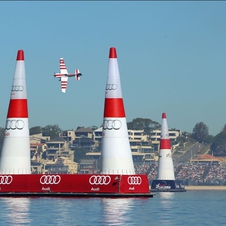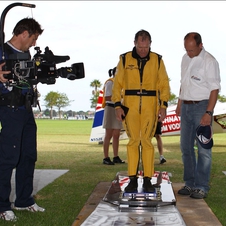Red Bull Air Race pays tribute to Earth Day
posted:
The Red Bull Air Race has managed to reduce its carbon footprint with the help of well-thought-out logistics
“We all have a responsibility for the planet, and we have put a lot of thought into improving efficiency and reducing emissions,” Loidl said. “The good thing about cutting emissions is that cost efficiency comes along with it. Protecting the environment is part of our philosophy and it’s a win-win as far as both goals are concerned.” Loidl added that the Red Bull Air Race is working on concrete plans to become carbon neutral in the near-term by investing in specific developing world projects to improve energy efficiency. “The goal of becoming carbon neutral is part of our responsibility.”
Even though the Red Bull Air Race World Championship has grown rapidly since its start in 2005 and now has 15 teams competing in eight races in eight different countries on five continents, the Red Bull Air Race has managed to reduce its carbon footprint with the help of well-thought-out logistics and an uncompromising campaign to keep down the volume and weight of materials shipped from location to location. This year the Red Bull Air Race has stops in Asia, Australia, South America, North America and Europe.
Most of the 350 to 420 tons of equipment used for each race is transported by sea freight rather than air freight – cutting both costs and emissions. There are two and sometimes three different sets of infrastructure that makes it possible to use the slower and more cost-efficient sea freight route rather than air cargo, which significantly lowers emissions. About 80 percent of the overall volume and 70 percent of the total weight for the race material is transported by ship. The rest – such as sensitive technical gear, expensive television broadcast equipment along with race planes – is airlifted between continents in two chartered Boeing 747 cargo planes most of the time. This year there will only be one cargo plane rather than two neededto move the race from North America to Europe. Because there is a long break in July, even the racing airplanes will be shipped by sea between the New York race in late June and the first European race in Germany in early August.
advertisment
The racing planes are remarkably efficient in their own right. Weighing a mere 540 kg, the propeller-driven aircraft use only about 8 litres of aviation fuel for each run through the track even though they are flying at speeds of up to 370 kph at up to 12G. The ‘smoke’ they use while in the track to help spectators, TV cameras and photographers follow their flight path is actually only a type of vapour. The pilots switch on their ‘smoke’ – paraffin and water – just before entering the race track and burn about 4 litres of it during their runs that harmlessly dissipates into the atmosphere.
The racing calendars each year are also planned with a careful eye of reducing emissions and costs. The Red Bull Air Race used freight trains, for example, rather than trucks between the two North American races in 2009, San Diego to Windsor to cut CO2 emissions and costs. The use of the somewhat slower freight trains also had the added advantage of eliminating storage costs because the material arrived just in time for the setting up of the Windsor race.
“We’re always looking for a better way to do things,” said Christof Reichl, Red Bull Air Race Logistics Manager. “Logistics is involved from the very start when the calendar is first being put together. We’re always looking for ways to reduce the amount of material and to pick the most efficient, cost-effective and low-emissions mode of transport. It just makes sense all around - saving money and cutting emissions at the same time. We’ve become more efficient each year and now we’re at the point where it’s getting harder and harder to find ways to cut costs and emissions. But we won't stop trying.”
As another small but effective example of cutting down on emissions and costs, the race used to need about 25 km of cable at each race location to connect areas like the race tower with the broadcast station, the media centre and other vital communications hubs. But by standardising the layout, organisers have managed to cut that to about 14 km of cable. “It might sound like only a detail, but every metre counts,” said Loidl. “The mass makes a vast difference. We’ve cut down the cable we take along to each race to about 14 km over the last few years.”
advertisment
The race also used to have two sets of hangars for the 15 teams but now has three this year so that they can be transported by sea to all eight races. With the first four races this year on four different continents all taking place within 12 weeks, the race would have needed a third cargo flight in a Boeing 747 to air lift the hangars and other material. But now there are three sets and the extra costs for the third set of equipment was mitigated by reduced transport costs and reduced emissions as well.Even as the championship, watched by an average of 530,000 spectators at each race, has grown rapidly, more and more of the back-shop support operations work is now done from Red Bull Air Race centres in Salzburg and London, thus further helping reduce the carbon footprint.
The local host city for each race also plays an important role in cutting emissions. The races are deliberately set in the heart of the host cities rather than in distant rural areas so that large crowds can follow the spectacular flying performances of the world’s top racing pilots. Going hand in hand with that, spectators, crew members and even VIPs use public transportation, bikes, and special shuttle buses to get to the race.
In Perth, for example, there were 36 bicycles used by crew members to get to and around the site. Local organisers closed off roads all around the racing area to encourage the use of public transportation, relieve congestion and avoid wasting space for car parks. Special shuttles were set up from rail stations and local organisers also added dozens of bike racks this year.
“There’s really an awful lot of thought and planning going into protecting the environment and cutting emissions at all levels,” said Hannah Walter, international production coordinator. “A race site like Perth is really good to get to with public transport or bikes so it’s easy to encourage people to take those options. At other races we do shuttle services and things like that to help people get to the event without their car. It’s the best option. It makes life easier for the spectators as well.”












